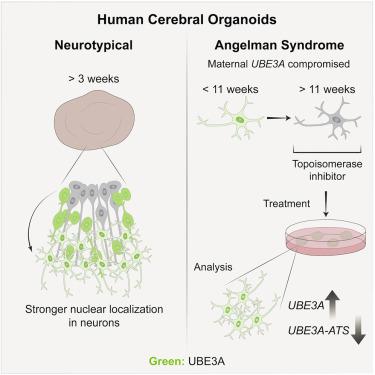Stem Cell Reports ( IF 5.9 ) Pub Date : 2020-09-10 , DOI: 10.1016/j.stemcr.2020.08.006 Dilara Sen 1 , Alexis Voulgaropoulos 1 , Zuzana Drobna 2 , Albert J Keung 1

|
Angelman syndrome is a complex neurodevelopmental disorder characterized by delayed development, intellectual disability, speech impairment, and ataxia. It results from the loss of UBE3A protein, an E3 ubiquitin ligase, in neurons of the brain. Despite the dynamic spatiotemporal expression of UBE3A observed in rodents and the potential clinical importance of when and where it is expressed, its expression pattern in humans remains unknown. This reflects a common challenge of studying human neurodevelopment: prenatal periods are hard to access experimentally. In this work, human cerebral organoids reveal a change from weak to strong UBE3A in neuronal nuclei within 3 weeks of culture. Angelman syndrome human induced pluripotent stem cell-derived organoids also exhibit early silencing of paternal UBE3A, with topoisomerase inhibitors partially rescuing UBE3A levels and calcium transient phenotypes. This work establishes human cerebral organoids as an important model for studying UBE3A and motivates their broader use in understanding complex neurodevelopmental disorders.
中文翻译:

人脑类器官揭示了UBE3A的早期时空动力学和药理反应。
Angelman综合征是一种复杂的神经发育障碍,其特征在于发育迟缓,智力障碍,语言障碍和共济失调。它是由脑神经元UBE3A蛋白(一种E3泛素连接酶)的丢失导致的。尽管在啮齿动物中观察到了UBE3A的动态时空表达,以及何时何地表达UBE3A的潜在临床重要性,但其在人类中的表达模式仍然未知。这反映出研究人类神经发育的共同挑战:产前时期很难通过实验获得。在这项工作中,人类大脑类器官在培养3周内揭示了神经元核中UBE3A从弱到强的变化。Angelman综合征人类诱导的多能干细胞衍生的类器官也表现出父本UBE3A的早期沉默,拓扑异构酶抑制剂可部分拯救UBE3A水平和钙瞬态表型。这项工作建立了人类大脑类器官作为研究UBE3A的重要模型,并激发了它们在理解复杂的神经发育障碍中的广泛应用。











































 京公网安备 11010802027423号
京公网安备 11010802027423号